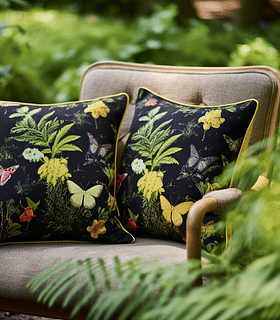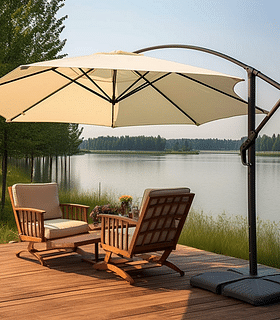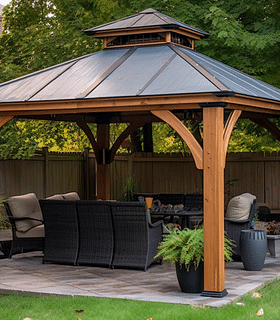How to Properly Maintain and Clean Your Outdoor Furniture
Discover the expert guide on maintaining and cleaning your outdoor furniture. Learn how to protect your garden furniture from rain and prevent mildew. Find out the best practices for cleaning outdoor furniture effectively.
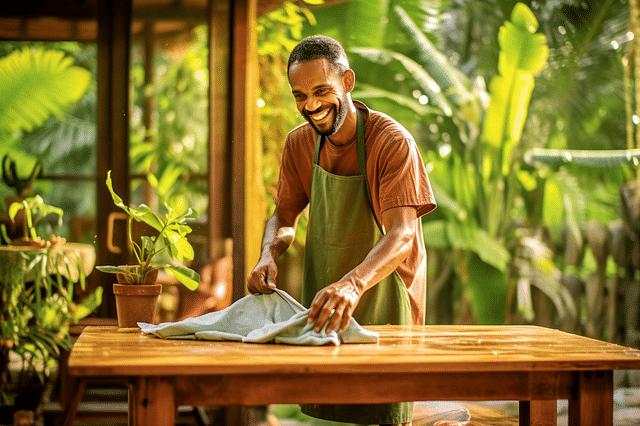
Have you ever looked out at your outdoor furniture and wondered how to keep it looking clean and well-maintained? Maybe you've noticed dirt and grime building up, or perhaps the cushions are starting to look a little worse for wear. If you've invested in outdoor furniture, you want to make sure it lasts for years to come.
In this blog post, we'll discuss the essential steps to properly maintain and clean your outdoor furniture. By following these tips, you can keep your furniture looking fresh and inviting for all your outdoor gatherings. Let's dive in!
Why is outdoor furniture maintenance important?
Outdoor furniture maintenance is an essential part of keeping your furniture in top-notch condition. Neglecting proper maintenance can lead to damage and deterioration, reducing the lifespan of your outdoor furniture. Regular maintenance helps to extend its lifespan and preserve its aesthetic appeal.
Extend the lifespan of your outdoor furniture
Regular maintenance is crucial in extending the lifespan of your outdoor furniture. Exposure to the elements such as sunlight, rain, and extreme temperatures can take a toll on furniture materials over time. Without proper care, wood can warp, metal can rust, and fabric can fade or become brittle.
By implementing a maintenance routine, you can protect your outdoor furniture from these harmful effects and ensure that it remains durable and functional for years to come. Simple tasks like cleaning, sealing, and storing your furniture properly can significantly extend its overall lifespan.
Preserve the aesthetic appeal of your outdoor furniture
In addition to prolonging its lifespan, regular maintenance helps to preserve the aesthetic appeal of your outdoor furniture. Outdoor furniture is often designed to enhance the beauty of your outdoor space, and neglecting its upkeep can result in a worn-out and unattractive appearance.
Cleaning your furniture regularly removes dirt, grime, and stains that can accumulate over time, restoring its original beauty. Applying protective coatings or treatments can help to prevent fading, discoloration, and damage from sun exposure. By maintaining your outdoor furniture's aesthetic appeal, you can create an inviting and visually pleasing outdoor environment.
Tips for maintaining outdoor furniture
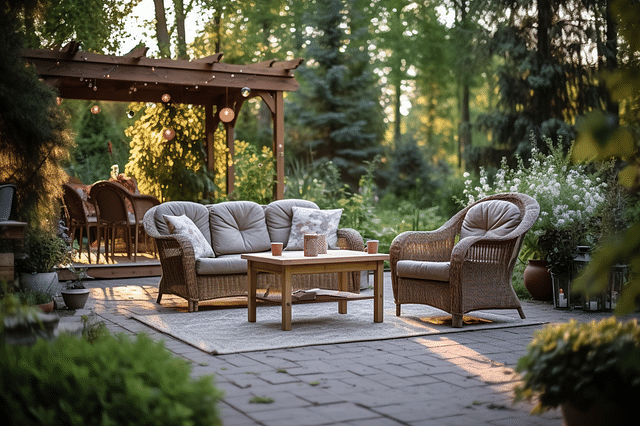
Outdoor furniture can greatly enhance your outdoor living spaces, providing a comfortable and inviting area to relax and entertain. However, to keep your outdoor furniture in tip-top shape and prolong its lifespan, regular maintenance is essential. In this section, we will explore some useful tips for maintaining your outdoor furniture.
Regular cleaning and dusting
Regular cleaning and dusting are crucial for keeping outdoor furniture looking fresh and preventing dirt buildup. Start by removing any loose debris, such as leaves or twigs, using a broom or a brush. Then, use a mild soap or detergent mixed with water to clean the surfaces thoroughly. Avoid using abrasive cleaners or scrub brushes, as they can damage the furniture's finish. Instead, opt for a soft cloth or sponge to gently scrub away dirt and stains.
After cleaning, rinse off the soap residue with a hose, making sure to remove all traces of cleaning solution. Allow the furniture to dry completely before using it again. Regular cleaning and dusting not only improve the appearance of your outdoor furniture but also help prevent the buildup of grime and protect it from corrosive substances like bird droppings or tree sap.
Protecting furniture from rain and moisture
One of the biggest threats to outdoor furniture is moisture, especially from rain and humidity. To protect your furniture from the damaging effects of water, consider investing in weatherproof covers or storage solutions. These covers are designed to shield your furniture from rain, snow, UV rays, and other environmental factors that can cause deterioration.
If you don't have access to covers, you can also move your furniture to a covered area during rainy seasons or use waterproof tarps to cover it temporarily. Additionally, ensure that your outdoor furniture is placed on a level surface to prevent water from pooling and causing damage.
Preventing mildew and mold growth
Mildew and mold can easily develop on outdoor furniture, particularly in humid or damp environments. To prevent their growth, it's essential to keep your furniture clean and dry. Regularly inspect your furniture for any signs of mildew or mold, such as black spots or a musty odor. If you notice any, promptly address the issue to prevent further spread.
To remove mildew or mold, create a solution of equal parts water and white vinegar and apply it to the affected areas using a soft brush or sponge. Let the solution sit for a few minutes, then rinse thoroughly with water. Alternatively, you can use a commercial mildew remover specifically designed for outdoor furniture.
In addition to regular cleaning, ensure proper airflow around your furniture by not placing it directly against walls or other objects. This helps to prevent moisture buildup and reduces the chances of mildew and mold growth.
By following these simple tips for regular cleaning and dusting, protecting your furniture from rain and moisture, and preventing mildew and mold growth, you can keep your outdoor furniture looking beautiful and extend its lifespan. So, take the necessary steps to maintain your outdoor furniture and enjoy its comfort and functionality for years to come.
Best practices for cleaning outdoor furniture

Outdoor furniture is exposed to various weather conditions and can accumulate dirt, stains, and even rust over time. Regular cleaning and maintenance will help keep your furniture looking its best and extend its lifespan. In this section, we will discuss the best practices for cleaning outdoor furniture and provide tips on how to clean different materials, remove stains and spills, and deal with rust and corrosion.
Cleaning different materials
Outdoor furniture can be made of different materials, including wood, metal, plastic, or wicker. Each material requires specific cleaning methods to prevent damage and maintain its appearance.
Wood: Start by removing loose dirt and debris using a soft brush or cloth. Use a mild soap mixed with water to clean the wood. Avoid using harsh chemicals or pressure washers as they can damage the finish. After cleaning, rinse thoroughly and allow the furniture to dry completely before applying a protective sealant or oil.
Metal: Use a mild soap mixed with water and a soft cloth or sponge to clean metal furniture. Rinse thoroughly and dry it completely to prevent water spots. Apply a coat of wax or automotive paste wax to protect the metal and add shine.
Plastic: Plastic furniture is relatively easy to clean. Use a mixture of mild soap and water along with a soft brush or sponge to remove dirt and stains. Rinse thoroughly and allow the furniture to air dry.
Wicker: Vacuum wicker furniture to remove loose dirt and dust. Use a soft brush or cloth to clean hard-to-reach areas. Wipe down the furniture with a mixture of mild soap and water, avoiding excessive moisture. Rinse with a damp cloth and allow it to dry completely.
Removing stains and spills
Accidents happen, and outdoor furniture may become stained from food spills, bird droppings, or other substances. Here are some tips to remove common stains from outdoor furniture:
Fabric: For fabric cushions or upholstery, remove any loose debris and gently blot the stain with a clean cloth or paper towel. Treat the stain with a mixture of mild soap and water or a fabric cleaner. Blot the area again until the stain is removed, and then let it air dry.
Metal: Use a mixture of mild soap and water and a soft cloth or sponge to clean metal surfaces with stains. For stubborn stains, use a non-abrasive cleaner or a paste made with baking soda and water. Rinse thoroughly and dry it completely.
Plastic: For plastic furniture, stains can often be removed with a mixture of mild soap and water. Use a soft brush or sponge to scrub the stain gently. Rinse thoroughly and allow the furniture to air dry.
Dealing with rust and corrosion
Rust and corrosion can deteriorate metal furniture if not addressed promptly. Here are some steps to remove rust and prevent further corrosion:
Loose rust: Use a wire brush or sandpaper to remove loose rust from the affected area. Scrub gently until the surface is smooth and clean.
Rust removal: Apply a commercial rust remover onto the rusted surface, following the manufacturer's instructions. Use a soft brush or cloth to rub the rusted area, removing the rust as much as possible. Rinse thoroughly and dry it completely.
Preventive measures: To prevent future rust and corrosion, apply a coat of rust-resistant primer or paint to the metal furniture. Regularly inspect the furniture for signs of rust or wear, and treat any small rust spots immediately to avoid further damage.
By following these best practices for cleaning outdoor furniture, you can maintain its appearance, prolong its lifespan, and enjoy your outdoor space to the fullest.
Trending products
Shop outdoor accessoriesFrequently asked questions
- What are the benefits of properly maintaining and cleaning outdoor furniture?
- Proper maintenance and cleaning helps extend the lifespan of your outdoor furniture, keeping it looking great for years to come. It also ensures comfort and safety, as regular maintenance helps identify and fix any potential issues early on.
- How often should I clean and maintain my outdoor furniture?
- It is recommended to clean and maintain your outdoor furniture at least once a season. However, if you live in a particularly harsh or rainy climate, it may be beneficial to clean more frequently.
- What steps should I take to protect my outdoor furniture from rain and water damage?
- To protect your outdoor furniture from rain and water damage, it is important to cover or store it during inclement weather. Using furniture covers or storing them in a shed or garage can help prevent water from seeping into the materials and causing damage.
- How do I prevent mildew from growing on my outdoor furniture?
- To prevent mildew growth on your outdoor furniture, make sure to clean and dry it thoroughly after rain or any exposure to moisture. Additionally, proper ventilation and airflow around your furniture can help inhibit the growth of mildew.
- What are some effective cleaning practices for outdoor furniture?
- When cleaning outdoor furniture, start by removing any loose dirt and debris. Then, use a mild soap or detergent mixed with water to gently scrub the surfaces. Rinse thoroughly and let the furniture dry completely before using it again.
- Can I use a pressure washer to clean my outdoor furniture?
- While pressure washers can be effective in removing dirt and grime, they should be used with caution on outdoor furniture. High-pressure water can cause damage to certain materials, so it is recommended to use a lower pressure setting and keep a safe distance when using a pressure washer.
- Are there any specific cleaning products I should avoid when cleaning outdoor furniture?
- It is best to avoid using harsh chemicals, bleach, or abrasive cleaners on outdoor furniture as they can cause damage to the surfaces. Opt for gentle cleaners that are specifically formulated for outdoor use.
- How can I protect outdoor furniture cushions and fabrics from stains and fading?
- To protect cushions and fabrics from stains and fading, consider applying a fabric protector spray that repels water and stains. Additionally, it is advisable to store cushions indoors or in waterproof storage bags when not in use.
- Should I oil or treat wooden outdoor furniture?
- Oiling or treating wooden outdoor furniture can help protect it from the elements and prolong its life. Follow the manufacturer's recommendations for the specific type of wood and use a high-quality outdoor wood oil or treatment product.
- What can I do to maintain the appearance of metal outdoor furniture?
- To maintain the appearance of metal outdoor furniture, regularly check for signs of rust or corrosion. If any are present, remove them using a gentle abrasive and touch up the affected areas with paint or a rust-resistant coating to prevent further damage.
Are you looking for more ideas?
Have a look at these other guides about improving your garden and patio to create your dream outdoor space!

Are you looking for more ideas?
-
- Role
- How to effectively eliminate ants on patio stones
- Description
- Get rid of patio stone ants once and for all! Learn effective methods and tips to eliminate ants from your patio stones and enjoy a pest-free outdoor space.
-
- Role
- How to easily remove a chain link fence
- Description
- Discover the simple steps to remove a chain link fence effortlessly. Our latest blog post breaks it down for you, making it easier than ever. Read on to learn more!
-
- Role
- How Long Does Patio Sealer Take To Dry?
- Description
- Discover the drying time for patio sealer and how long it takes for your patio to be ready for use. Find out the best tips to minimize drying time and ensure a long-lasting, beautiful outdoor space.
-
- Role
- Update Your Fence: Paint vs. Stain - Pros and Cons Explained
- Description
- Paint or stain? Discover the pros and cons of updating your fence. Make an informed decision with our in-depth analysis.

